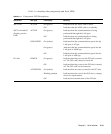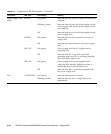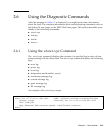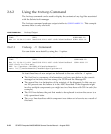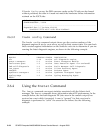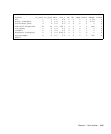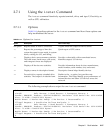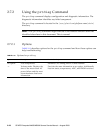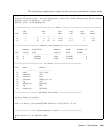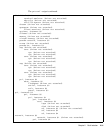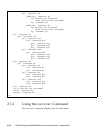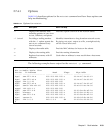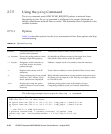
Chapter 2 Fault Isolation 2-27
2.7.1 Using the iostat Command
The iostat command iteratively reports terminal, drive, and tape I/O activity, as
well as CPU utilization.
2.7.1.1 Options
TABLE 2-12 describes options for the iostat command and how those options can
help troubleshoot the server.
The following example shows output for one iostat command.
TABLE 2-12 Options for iostat
Option Description How It Can Help
No option Reports status of local I/O devices. A quick three-line output of device status.
-c Reports the percentage of time the
system has spent in user mode, in system
mode, waiting for I/O, and idling.
Quick report of CPU status.
-e Displays device error summary statistics.
The total errors, hard errors, soft errors,
and transport errors are displayed.
Provides a short table with accumulated errors.
Identifies suspect I/O devices.
-E Displays all device error statistics. Provides information about devices: manufacturer,
model number, serial number, size, and errors.
-n Displays names in descriptive format. Descriptive format helps identify devices.
-x For each drive, reports extended drive
statistics. The output is in tabular form.
Similar to the
-e option, but provides rate
information. This helps identify poor performance of
internal devices and other I/O devices across the
network.
# iostat -En
c0t0d0 Soft Errors: 0 Hard Errors: 0 Transport Errors: 0
Vendor: SEAGATE Product: ST973401LSUN72G Revision: 0556 Serial No: 0521104T9D
Size: 73.40GB <73400057856 bytes>
Media Error: 0 Device Not Ready: 0 No Device: 0 Recoverable: 0
Illegal Request: 0 Predictive Failure Analysis: 0
c0t1d0 Soft Errors: 0 Hard Errors: 0 Transport Errors: 0
Vendor: SEAGATE Product: ST973401LSUN72G Revision: 0556 Serial No: 0521104V3V
Size: 73.40GB <73400057856 bytes>
Media Error: 0 Device Not Ready: 0 No Device: 0 Recoverable: 0
Illegal Request: 0 Predictive Failure Analysis: 0
#



